GREENEVILLE – Girl Scouts learned about the impact of plastics on waterways, animals and humans from samples they took in a creek at Tusculum University.
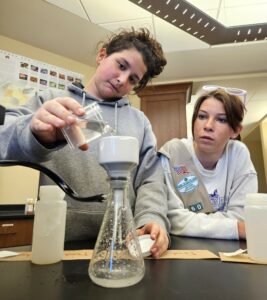
Girl Scouts filter a water sample in the Meen Center.
Eleven members of the Girl Scouts of the Southern Appalachians visited Tusculum Saturday, April 13, for a day of activities centered on microplastics. They took water samples from three locations within College Creek and processed and examined them in the environmental science wing of the Meen Center. They also created a poster summarizing why plastics are an issue for wildlife and humans and presenting potential ideas for reducing this material in the environment.
“We were pleased to partner with the Girl Scouts to provide these members with valuable information about a serious environmental matter,” said Dr. Heather Henson-Ramsey, dean of Tusculum’s College of Science, Technology and Mathematics. “Those Girl Scouts who were unaware of the damage plastics can cause will now have a better understanding and possibly become involved in solutions for microplastics.
“Providing this knowledge to these Girl Scouts is part of our commitment to civic engagement. Having them learn by visiting and performing work in the creek demonstrates the value of our active and experiential approach to education.”
Lynnea Salinas, programs manager for Girl Scouts of the Southern Appalachians, said the Girl Scouts earned two environmental stewardship badges and a patch as a result of their visit to Tusculum. The day was part of the organization’s overall mission to build girls of courage, confidence and character. All of the badges Girl Scouts receive during their membership line up under four of the organization’s pillars – entrepreneurship; outdoors; science, technology, engineering and mathematics; and life skills.
“We want our Girl Scouts to get a smattering of all different types of experiences,” Salinas said. “They wouldn’t get an experience like this in their regular classroom. It also gets the Girl Scouts out with others their own age and interests. Maybe one of them will say, ‘Wow, this was amazing. I’m really into biology and I didn’t realize that before.”
In attendance Saturday were Girl Scouts from Greeneville and as far away as Big Stone Gap, Virginia, and Chattanooga. Dr. Henson-Ramsey; Jordan Baker, assistant professor of biology; and Dr. Kate Smith, associate professor of psychology, taught the group. Tusculum student Skylar Lane assisted them.
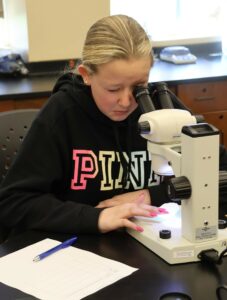
A Girl Scout looks at a filtered water sample under a microscope.
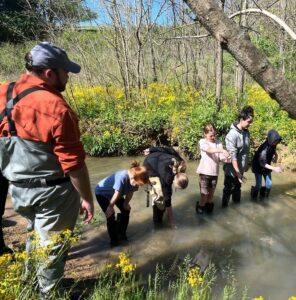
Girl Scouts collect water samples with guidance from Jordan Baker, left, a biology professor at Tusculum.
During their time on campus, the Girl Scouts gathered samples from the creek close to the Erwin Highway, near the outdoor classroom on the university’s nature trail and close to Gilland Street and the Paul E. Hayden Educational Wetland. The purpose was to determine whether a correlation exists between proximity to the road and the amount of plastics in the water. The group started with the idea there might be more plastics close to the road and less downstream.
Dr. Henson-Ramsey, who leads the cadettes portion of Girl Scout Troop 1090 in Greeneville, explained that people cannot see microplastics with the naked eye because they are so small. The problem is they can nonetheless clog the intestines of small fish, crayfish and anything that is drinking and eating prey in the water. The animals will either not feel full because of the plastics in their body or have a blocked digestive system.
Plastics can enter a waterway when a beverage bottle is crushed by a tire in the roadway, she said. Tires also have some plastics in them that can reach the water when a car drives over a bridge. Other items with plastics in them that can find their way to water in a variety of ways are clothing, makeup and toothpaste containers.
“There has been a lot of research on plastics in marine systems because of large trash piles that are floating in the ocean,” Dr. Henson-Ramsey said. “But there hasn’t been nearly as much research on plastics in fresh water systems. But plastics are there. Our work with the Girl Scouts was not a formal study, but it clearly showed the prevalence of plastics materials in our waterways, too.”
Once they collected the samples, the Girl Scouts returned to the environmental science laboratory to begin analyzing what they collected. They filtered the samples onto paper and then put them under a microscope so they could try to find and identify how many types of plastics they saw. Most of the small teams of Girl Scouts found more plastics in the samples from close to the road.
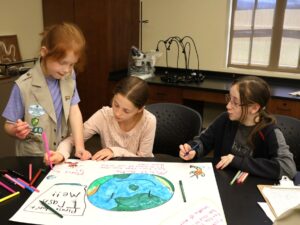
Three Girl Scouts work on their poster.
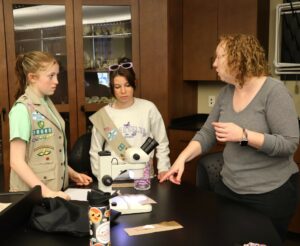
Dr. Kate Smith, right, a Tusculum psychology professor, instructs two Girl Scouts.
“Knowing exactly the type of plastics we found would require a chemical analysis, but we identified them based on just appearance,” Dr. Henson-Ramsey said. “The majority of them are called plastic fibers or filaments, which are probably from clothing and things like that. They are the easiest to identify because of their color. There are probably items from a plastic bottle by the roadway, but they are harder to identify.”
In addition to the water samples, the Girl Scouts participated in an activity that demonstrated the challenge for wildlife to avoid consuming plastics when they eat.
Salinas said the Girl Scouts likes to collaborate with higher education institutions because of resources they have that are not available to her organization. Coming to places such as Tusculum enable Girl Scouts to experience being on a college campus and have access to experts as well as special equipment and materials, she said.
“We are grateful to Tusculum for inviting us to campus,” Salinas said. “The activities were extremely helpful to the Girl Scouts, and we look forward to returning so they can obtain additional knowledge about scientific items.”
Further information about the Girl Scouts of the Southern Appalachians is available at https://www.girlscoutcsa.org/. People can access additional details about Tusculum’s environmental science program at https://site.tusculum.edu/environmental-science/. To learn more about the university, please visit www.tusculum.edu.


